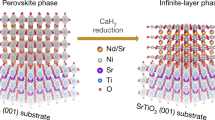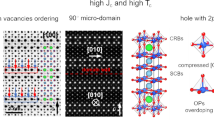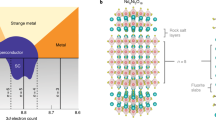Abstract
STARTING with the pioneering work of Bednorz and Müller1, many copper-oxide-based superconductors with high transition temperatures (Tc) have been discovered. All contain layers of copper-oxygen squares, pyramids or octahedra as their electronically active structural components2,3. One structure type, first reported for La2SrCu2O6 and La2CaCu2O6 (ref. 4), has stood as an enigma since the beginning of high-Tc research. This crystal structure4-7 (Fig. 1) is the least complex of all the structures with the double layers of copper oxide pyramids common to the compounds with highest Tc, yet despite considerable effort, both published8,9 and unpublished, it has not until now been made superconducting. Here we report the successful synthesis and preliminary physical characterization of superconducting (La, Sr)2CaCu2O6. The highest transition temperature observed is 60 K at the composition La1.6Sr0.4CaCu2O6. This is a uniquely simple double-layer superconductor, which, like its single-layer analogue (La, Sr)2CuO4, becomes superconducting through the introduction of carriers in an unambiguous manner—by straightforward atomic substitution without the intervention of charge reservoir layers with flexible valence states.
This is a preview of subscription content, access via your institution
Access options
Subscribe to this journal
Receive 51 print issues and online access
$199.00 per year
only $3.90 per issue
Buy this article
- Purchase on Springer Link
- Instant access to full article PDF
Prices may be subject to local taxes which are calculated during checkout
Similar content being viewed by others
References
Bednorz, J. G. & Müller, K. A. Z. Phys. B64, 189–193 (1986).
Sleight, A. W. Science 242, 1519–1527 (1988).
Cava, R. J. Science 247, 656–662 (1990).
Nguyen, N., Er-Rakho, L., Michel, C., Choisnet, J. & Raveau, B. Mater. Res. Bull. 15, 891–897 (1980).
Santoro, A., Beech, F. & Cava, R. J. High T c Symposium, Materials Research Society Proceedings Series Vol. 169 (in the press).
Izumi, F., Takayama-Muromachi, E., Nakai, Y. & Asano, H. Physica C157, 89 (1989).
Caignaert, V., Nguyen, N. & Raveau, B. Mater. Res. Bull. 25, 199–204 (1990).
Tamegai, T. & Iye, Y. Physica C159, 181–187 (1989).
Torrance, J. B., Tokura, Y., Nazzal, A. & Parkins, S. S. P. Phys. Rev. Lett. 60, 542–545 (1988).
Cava, R. J., van Dover, R. B., Batlogg, B. & Reitman, E. A. Phys. Rev. Lett. 58, 408–410 (1987).
Tarascon, J. M., Greene, L. H., McKinnon, W. R., Hull, G. W. & Geballe, T. H. Science 235, 1373–1375 (1987).
Torrance, J. B. et al. Phys. Rev. Lett. 61, 1127–1131 (1988).
Author information
Authors and Affiliations
Rights and permissions
About this article
Cite this article
Cava, R., Batlogg, B., van Dover, R. et al. Superconductivity at 60 K in La2-xSrxCaCu2O6: the simplest double-layer cuprate. Nature 345, 602–604 (1990). https://doi.org/10.1038/345602a0
Received:
Accepted:
Issue Date:
DOI: https://doi.org/10.1038/345602a0
This article is cited by
-
Theoretical Study of Specific Heat, Density of States, Free Energy, and Critical Field of High Temperature Cuprate Superconductors Based on Intra and Interlayer Interactions
Journal of Superconductivity and Novel Magnetism (2008)
-
Thermodynamic reassessment of the Cu-O phase diagram
Journal of Phase Equilibria and Diffusion (2005)
-
Phase diagrams for the YBa2Cu3O7 family — ANNO 1996
Journal of Thermal Analysis (1997)
-
Two distinct structural phases in Sr3?x Ca x Ru2O y
Journal of Low Temperature Physics (1996)
-
Effect of interlayer interaction in high-T c cuprate superconductors
Journal of Superconductivity (1996)
Comments
By submitting a comment you agree to abide by our Terms and Community Guidelines. If you find something abusive or that does not comply with our terms or guidelines please flag it as inappropriate.



